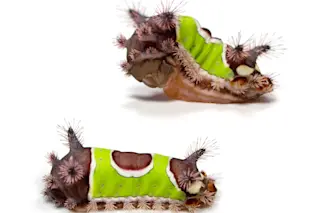Caterpillars have evolved over millions of years to defend themselves against predators. Over those years of evolution, the insect larvae have split into different geneses that sport vibrant colors, mesmerizing shapes and sharp thorns of distinctive tints and sizes.
Learn more about the diverse venomous caterpillars worldwide and their tactics to survive from attacking predators.
Are Caterpillars Poisonous?
While some caterpillars don't show spikes at all, they advertise their toxicity with their stripes and shades. A prime example is the Monarch caterpillar, which sports stripes interchanging between yellow, white, and black.
"They're advertising that they're Clint Eastwood. That they're badasses, and they know it. Obviously, they want to be seen and they want you to know that they're there because they're chemically protected," says David Wagner, an entomologist at the University of Connecticut.
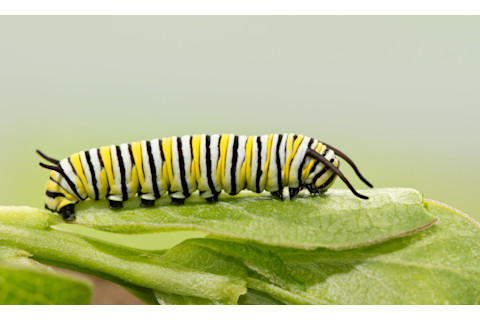
(Credit:Sari ONeal/Shutterstock)
Other caterpillars have developed a venom that deters predators interested in a snack, irritating hairs, toxins that make them poisonous to eat, or spines that inject venoms, like the defense mechanisms of scorpions or spiders. To survive into adulthood, the larvae rely on the irritating hairs, stings or the chemical protection gained by the plants they eat as young larvae.
"There's lots of caterpillars that are very toxic, that we shouldn't be eating. There's also lots that sting, but there's far more that are chemically or physically protected," says Wagner.
Evolution of Setae Spines
Where did these caterpillar protections come from? One specimen trapped in Cretaceous amber dates to 100 million years old and reveals armored spikes along its trunk segments. The fossil, published in Gondwana Research in 2021, is one of four ambers that shows the early diversification of moths and butterflies. It’s one of the few examples of how caterpillars used spikes to protect themselves even against the earliest birds.
The spikes proved helpful and now adorn many different caterpillars today. These dense, long hairs seen on caterpillars are specialized physical armor that ward off hungry birds and other insects looking for their next snack.
"Insects have been around for millions and millions of years, and there's plenty of things that they're trying to eat, and there are plenty of things trying to eat insects. So, it's always this arms race," says PJ Leisch, an entomologist and director of the University of Wisconsin-Madison's Insect Diagnostic Lab.
5 Venomous Caterpillars
Of these insects, there are many different types of caterpillars and forms of protection. Some venom can even be deadly to humans. Keep an eye out for these five species.
1. Slug Caterpillars

(Credit:Steve Byland/Shutterstock)
Slug caterpillars, known for their oddly, gummy candy-shaped and flattened bodies, belong to Limacodidae. About 1000 insects belonging to the family are found worldwide but are concentrated in the tropics. The caterpillars sport suckers on their undersides that let the larvae glide and stick to the bottoms of leaves. Many of these species are brightly colored and have protuberances and stinging hairs known as setae, that can cause a rash to humans that touch them.
The saddleback caterpillar (Acharia stimulea), about three fourths inches long, has distinctive venomous spines surrounding a saddle-like patch on its back. Saddlebacks are native to the eastern U.S. from Massachusetts to Florida and also west to eastern Missouri and Texas. These caterpillars feed on various host plants. It will use its protruding spines to ward off attacking paper wasps and other predators when disturbed. Their sting is comparable to a bee or jellyfish sting.
"Gardeners get hit by this one a lot because that one's often on low plants [and] can even be on grasses, and often ends up in the vegetable garden," Wagner says. "If you grab that one the wrong way, you'll be really sorry for about three or four hours. Again, it's mostly like just an intense stinging nettle that won't go away for a while."
Venom from these stings can cause hives, a burning sensation around the contact zone, and more severe symptoms like migraines, gastrointestinal symptoms, asthma complications, and, in some cases, hemorrhaging.
Read More: 8 Facts You Didn't Know About Venom and Toxic Animals
2. Asp Caterpillars (Flannel Moths)
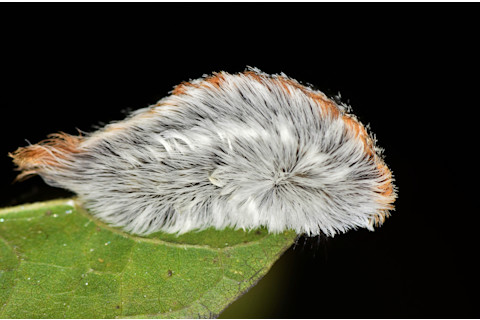
(Credit: Brett Hondow/Shutterstock)
Brett Hondow/Shutterstock
Also known as the puss caterpillar (Megalopyge opercularis), the larvae of the flannel moth is one of the most venomous caterpillars in the U.S. At one inch long, they may appear harmless with their soft tuft of swept-back setae, but underneath are stinging barbs.
"Those guys have a really serious sting that is quite uncomfortable for up to three to four hours, and if you were to get this inside your clothing, or it gets pressed against your skin, you're in for a pretty miserable 24 hours," Wagner says.
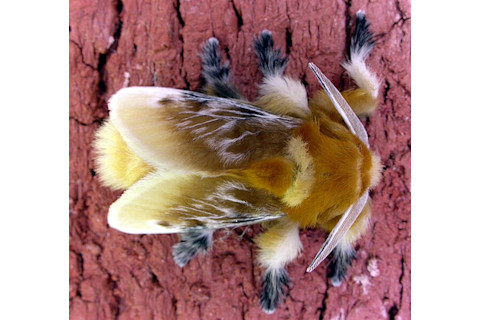
(Credit: Patrick Coin/Wikimedia Commons (CC-by-sa-2.5)
Patrick Coin/Wikimedia Commons (CC-by-sa-2.5
The hollow stinging barbs underneath can easily break off and have a venom gland at its base. The result is a weeping wound on the skin that will try to rid the body of the venom.
"It will usually kill all the cells in the vicinity of where each of those setae went in. And so, you can see three days later where every damn setae that penetrated your skin happened because it will kill the cells," Wagner says. Joints near the wound will also get sore for about 24 hours.
Read More: Scientists Found a Caterpillar That Eats Plastic. Could It Help Solve our Plastic Crisis?
3. Giant Silkworm Caterpillars (Lonomia moths)

Assassin caterpillar (Lonomia obliqua) (Credit: DNM Medeiros et al., 2014)
DNM Medeiros et al., 2014
Venom from giant silkworm caterpillars is as potent as a rattlesnakes venom. Lonomia, a genus of moths found in Central and South America is known to be deadly and venomous. The caterpillars are masters of disguise. Blending low into the bark of trees in the rainforests of Brazil, they can easily poke anyone who accidentally brushes past. The larvae are known as Lonomia achelous, the Brazilian caterpillar, and Lonomia obliqua, the assassin caterpillar.
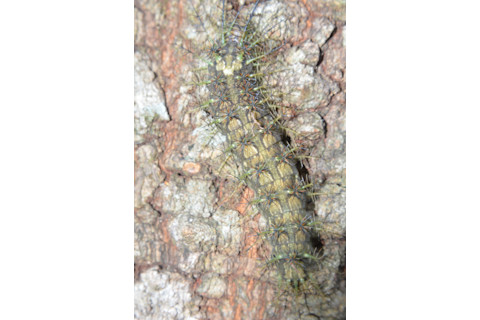
(Credit: FabioMaffei/Getty Images)
FabioMaffei/Getty Images
Experts have collected over a thousand cases of poisoning between 1997 and 2005, with several human deaths occurring every year. However, the numbers are not exact due to accidents happening in rural areas. Assassin caterpillars carry their potent venom inside of spiny protrusions. When they puncture human skin, they release their venom, which contains anti-clotting agents.
Once stung, widespread hemorrhagic symptoms can occur, along with kidney failure, pulmonary hemorrhage and intracranial hemorrhaging that happen up to 72 hours after the encounter. The assassin caterpillar is known as the most venomous caterpillar in the world and was classified by Guinness World Records in 2014. An antivenom only for caterpillars in the Lonomia genus exists.
Read More: The Silkworm Road: How A Moth Became An Economic Powerhouse
4. IO Moth Caterpillar

(Credit:Cathy Keifer/Shutterstock)
IO ,(Automeris io), which also belong to the giant silkworm moth family Saturniidae, also have stinging spines filled with venom. There are various species in this group, and some are more toxic than others. The larvae are about 60mm when full grown, green and sport a lateral white and red stripe.

(Credit:Cathy Keifer/Shutterstock)
The spikes adoring the caterpillar are venomous, and its sting is comparable to a bee sting. The spines can break off into the skin, and how many spikes embedded determines how harmful the sting is. These insects are found from Southern Canada to Florida and Texas.
Read More: The Butterfly with a Dozen Disguises
5. The Faithful Beauty Caterpillar
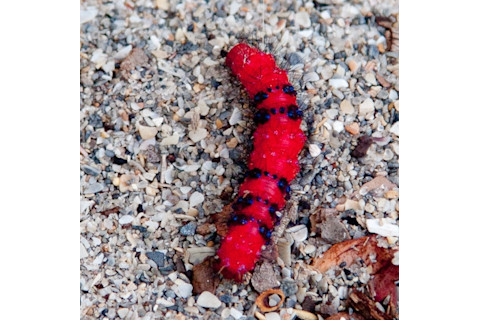
(Credit: John Bradford, CC BY-ND-NC 1.0)
John Bradford, CC BY-ND-NC 1.0
The faithful beauty (Composia fidelissima) is a bright, red-colored caterpillar with purplish bands and spiked setae along its body. While their spikes are not connected to venom glands, it is chemically protected like a monarch caterpillar. Its host plants include Devil's potato, oleander, Leafless swallowwort, and bay bean, which give it its toxic features. The insect is found in the American tropics.
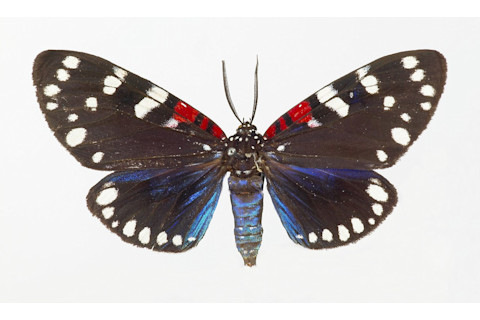
(Credit: Yale University/Public domain)
Yale University/Public domain
As a moth, when a predator captures the faithful beauty, it releases poison from the back of its head as a defense mechanism. The moth, if successfully eaten, is also poisonous.
"These venoms were designed to discourage monkeys from playing around with caterpillars. I never got the memo. I really enjoy caterpillars tremendously. Almost all the toxic ones I'll pick up if [I] handle them very gently. I don't recommend it to anybody else, but they can be handled," Wagner says.
Read More: How the Smallest Butterfly in North America Travels Using Gusts of Wind


